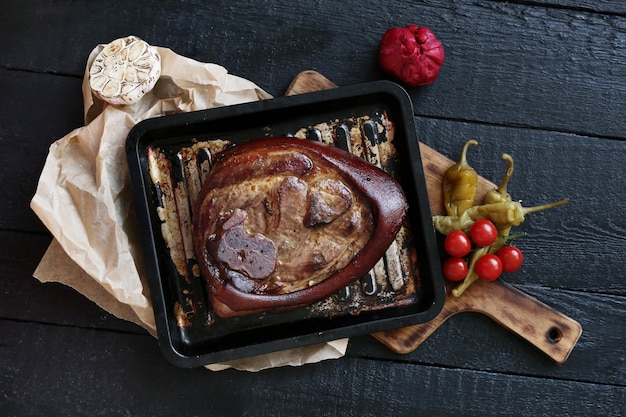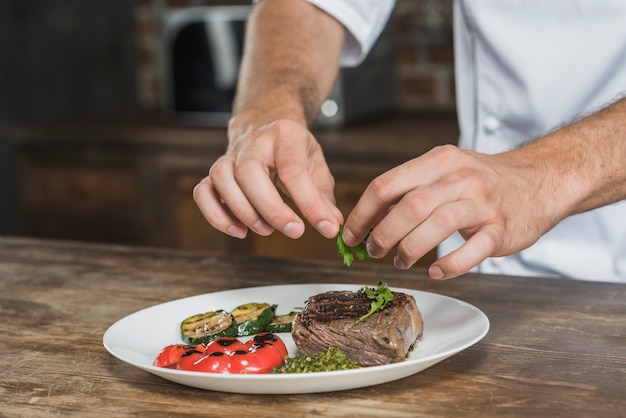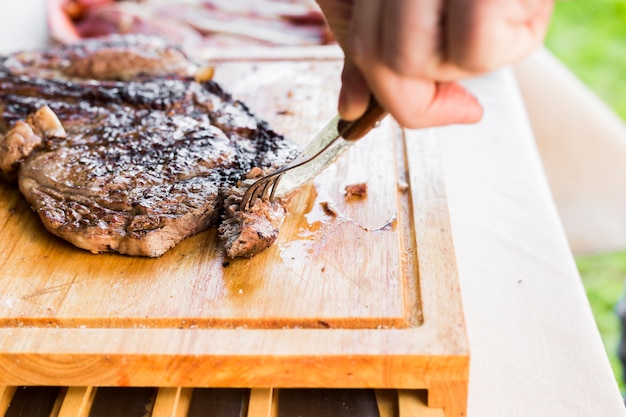I've always loved the simplicity and versatility of pork tenderloin. It’s a lean, flavourful cut that's perfect for everything from a quick weeknight dinner to a fancy special occasion. And one of my go-to ways to cook it is in the oven at 350 degrees fahrenheit. It's a method that consistently delivers juicy, tender meat with a gorgeous golden-brown crust. But let's be honest, getting that perfect balance between tenderness and doneness can be a bit tricky. That's why I've put together this comprehensive guide to help you master the art of oven-baked pork tenderloin at 350 degrees.
From the essential cooking times to creative seasoning ideas, we'll cover everything you need to create a pork tenderloin that's sure to impress. So, grab your apron, gather your ingredients, and let's get cooking!
Part 1: Understanding Pork Tenderloin

Before we jump into the details of cooking time, it's important to understand the star of the show - the pork tenderloin. This lean cut comes from the loin of the pig, and it's usually quite small, often weighing around 1-2 pounds. The key to success with pork tenderloin is keeping it moist and tender. Overcooked, it can become dry and tough, a culinary tragedy we want to avoid at all costs!
Choosing the perfect pork tenderloin
The quality of your pork tenderloin plays a big role in the final result. When choosing, look for a tenderloin that's firm and has a lovely light pink colour. Avoid any that look greyish, as that could mean it's not as fresh. And feel free to give it a gentle squeeze - it should feel firm and springy.
Personally, I always opt for organic or free-range pork whenever possible. It often has a richer flavour and is a more humane choice. But ultimately, it's your preference and what's readily available at your local butcher or supermarket.
Understanding Cooking Time
Cooking time for pork tenderloin at 350 degrees depends on its size. A good rule of thumb is to bake it for 20-25 minutes per pound. But it's always best to use a meat thermometer to ensure it's cooked to perfection. The USDA recommends an internal temperature of 145 degrees Fahrenheit for pork tenderloin. This ensures it's safe to eat while preventing it from becoming dry and tough.
Think of the thermometer as your culinary compass, guiding you towards the perfect level of doneness. It's a small investment that pays off big time in terms of deliciousness and peace of mind.
Part 2: Preparing the Pork Tenderloin

Now that we've chosen our tenderloin and are armed with the basics of cooking time, let's prepare it for the oven. Here's a step-by-step guide to getting your pork tenderloin ready to cook:
1. Trimming the Fat
Start by trimming any excess fat from the tenderloin. While a little fat adds flavour, too much can make the meat greasy and might lead to uneven cooking. Use a sharp knife and carefully trim away the excess, leaving a thin layer behind for flavour and moisture.
2. Patting it Dry
Once you've trimmed the fat, pat the tenderloin dry with paper towels. This is crucial for removing any excess moisture. If the meat is too wet, it can create steam in the oven, preventing a crisp, golden-brown crust from forming.
3. Seasoning the Tenderloin
Now for the fun part - seasoning! This is where you can unleash your creativity and explore different flavour profiles. You can keep it simple with salt and pepper, or go wild with a blend of herbs and spices.
For a classic flavour, I love a simple mix of salt, pepper, garlic powder, and onion powder. It's a combination that always delivers a satisfying punch of flavour. For something a little more adventurous, try a Moroccan-inspired spice rub with cumin, paprika, and coriander. The earthy and aromatic notes are incredible with pork.
No matter what you choose, be generous with your seasoning. You can also rub it into the meat for even more intense flavour.
Part 3: Cooking the Pork Tenderloin at 350 Degrees

With the pork tenderloin prepped and ready to go, it's time to put it in the oven. Here's how to cook your pork tenderloin to perfection at 350 degrees Fahrenheit:
1. Preheating the Oven
Start by preheating your oven to 350 degrees Fahrenheit (175 degrees Celsius). This ensures even cooking and helps the tenderloin develop that beautiful golden-brown crust. It's a simple step that makes a big difference in the final result.
2. Roasting the Pork Tenderloin
Place the seasoned tenderloin on a baking sheet or in a roasting pan. If you're using a baking sheet, I recommend lining it with parchment paper for easy cleanup.
Roast the tenderloin for 20-25 minutes per pound, or until the internal temperature reaches 145 degrees Fahrenheit. You can use a meat thermometer to check the temperature. Insert the thermometer into the thickest part of the tenderloin, making sure it doesn't touch bone.
Remember that cooking times can vary slightly based on the size and shape of your tenderloin, and even the temperature of your oven. It's always best to check the temperature a few minutes before the estimated cooking time is complete.
3. Resting the Pork Tenderloin
Once the tenderloin has reached the desired temperature, remove it from the oven and let it rest for 10-15 minutes before slicing. This allows the juices to redistribute throughout the meat, creating a more tender and flavourful dish. Think of it as giving your pork tenderloin a mini-spa treatment to recover from the heat of the oven.
Part 4: The Importance of Resting
Resting the pork tenderloin isn’t optional. It’s essential for achieving the best possible results. Here's why:
When the tenderloin comes out of the oven, the muscle fibres are tense. Resting allows those fibres to relax, releasing the juices that have been trapped inside. This results in incredibly tender and flavourful meat. It's like giving your pork tenderloin a little time to unwind and share its deliciousness with you.
How to Rest a Pork Tenderloin
To rest the tenderloin, transfer it to a cutting board and cover it loosely with foil. Don't worry, it won't get cold in this short amount of time. The foil helps to retain the heat and prevent the tenderloin from drying out. Let it rest for 10-15 minutes before carving. You'll be amazed at how much juicier and more flavourful it becomes.
Part 5: Delicious Serving Options
Now that your pork tenderloin is perfectly cooked and rested, it's time to enjoy the fruits of your culinary labour. There are endless ways to serve pork tenderloin, depending on your taste and the occasion.
1. Simple and Elegant
For a simple and elegant meal, slice the tenderloin into thin medallions and serve it with a side of roasted vegetables, such as asparagus or Brussels sprouts. A drizzle of pan sauce or gravy adds a touch of elegance and extra flavour.
2. Comforting and Hearty
If you're craving something comforting and hearty, try serving the tenderloin with mashed potatoes and gravy. It's a classic combination that never fails to satisfy.
3. A Touch of Adventure
For those who enjoy exploring new flavours, try grilling pineapple slices and serving them alongside the tenderloin. The sweet and tangy flavour of the pineapple complements the pork beautifully.
Part 6: Tips for Perfect Results
Here are a few extra tips to help you achieve consistently delicious results when cooking pork tenderloin at 350 degrees:
- Don’t overcrowd the pan: If you're cooking multiple tenderloins, make sure you give them enough space to breathe. Overcrowding can prevent the meat from cooking evenly and can lead to steam buildup, making the crust soggy.
- Basting for Extra Juiciness: For extra juiciness, consider basting the tenderloin with pan juices or butter while it's cooking. This helps to keep the meat moist and prevents it from drying out. Use a basting brush to apply the pan juices or butter every 10-15 minutes.
- Cooking Time Variations: Remember that cooking times can vary slightly depending on the size and shape of your tenderloin, as well as the temperature of your oven. Always check the internal temperature using a meat thermometer to ensure it's cooked to your desired level of doneness.
Part 7: Common Mistakes to Avoid
Even the most seasoned cooks can make a few mistakes, and pork tenderloin is no exception. Here are a few common blunders to avoid when cooking pork tenderloin at 350 degrees:
- Overcooking: Overcooking is a common mistake that can make the tenderloin dry and tough. Always use a meat thermometer to ensure it's cooked to the proper internal temperature.
- Under-seasoning: Under-seasoning can lead to a bland and flavourless tenderloin. Season generously and don't be afraid to experiment with different spice blends.
- Not Resting Long Enough: Not resting the tenderloin long enough before carving can result in a less juicy and flavorful dish. Always allow the tenderloin to rest for at least 10-15 minutes before slicing.
Part 8: Pork Tenderloin Variations
Once you've mastered the basics of cooking pork tenderloin at 350 degrees, you can start experimenting with different variations. Here are a few ideas to get your culinary juices flowing:
1. Stuffed Pork Tenderloin
Stuff the tenderloin with a mixture of herbs, cheese, or sausage for a more flavorful and satisfying meal. To stuff the tenderloin, make a slit down the center of the meat, but don’t cut all the way through. Stuff the tenderloin with your desired filling, then tie it closed with kitchen twine or use toothpicks to secure the stuffing.
2. Glazed Pork Tenderloin
For a sweet and savory flavour, glaze the tenderloin with a honey-mustard glaze or a balsamic glaze. The glaze will caramelize in the oven, creating a delicious and sticky coating.
3. Pan-Seared Pork Tenderloin
For a crispy crust and a juicy interior, pan-sear the tenderloin before roasting. This will create a beautiful sear that adds depth of flavor. Just make sure to brown all sides of the tenderloin before placing it in the oven to roast.
Part 9: Pork Tenderloin FAQs
Now that we've covered the basics of cooking pork tenderloin at 350 degrees, let's address some common questions:
1. Can I Cook a Frozen Pork Tenderloin at 350 Degrees?
It’s not recommended to cook a frozen pork tenderloin at 350 degrees. The meat will cook unevenly, and it may not reach a safe internal temperature. It’s best to thaw the pork tenderloin in the refrigerator overnight before cooking.
2. How Do I Know If My Pork Tenderloin is Done?
The best way to tell if your pork tenderloin is done is to use a meat thermometer. The USDA recommends an internal temperature of 145 degrees Fahrenheit. You can also check for doneness by pressing the meat. If it springs back to the touch, it’s done.
3. What If My Pork Tenderloin Is Overcooked?
If your pork tenderloin is overcooked, it will be dry and tough. There’s not much you can do to salvage an overcooked tenderloin. However, you can try slicing it thinly and using it in other dishes, such as a stir-fry or soup.
4. Can I Marinate Pork Tenderloin Before Cooking?
Yes, you can marinate pork tenderloin before cooking. Marinating will add flavor and help to keep the meat moist. Use a marinade of your choice, but be sure to let the tenderloin marinate for at least 30 minutes, or up to 24 hours in the refrigerator.
5. Can I Reheat Cooked Pork Tenderloin?
Yes, you can reheat cooked pork tenderloin. The best way to reheat it is to place it in a preheated oven at 350 degrees Fahrenheit for 10-15 minutes. You can also reheat it in the microwave. Just be sure to heat it through to a safe internal temperature of 145 degrees Fahrenheit.
Conclusion: The Joy of a Perfectly Cooked Pork Tenderloin
So there you have it, a comprehensive guide to cooking pork tenderloin at 350 degrees. I hope this information has given you the confidence to tackle this versatile cut of meat with ease. Whether you’re a seasoned cook or a beginner, remember that practice makes perfect. Don’t be afraid to experiment with different seasoning blends, marinades, and cooking techniques.
Every time I cook a perfectly tender and juicy pork tenderloin, it reminds me of the simple pleasures of cooking. It’s a reminder that with a little care and attention, even the simplest ingredients can create a delicious and memorable meal. So, get your oven preheated, gather your ingredients, and enjoy the journey of cooking a delightful pork tenderloin at 350 degrees.
Everyone is watching

Corn on the Cob: The Ultimate Guide to Perfectly Cooked Ears
Healthy MealsAh, corn on the cob. Just the name evokes images of sunny days, barbecues, and that sweet, juicy flavour that ...

Perfect Pork Roast Oven Cooking Time: A Guide to Delicious Results
Healthy MealsThere's something truly satisfying about a perfectly roasted pork. The aroma alone is enough to make your mout...

Ham Cooking Time: How Long to Bake, Smoke, or Boil a Delicious Ham
Healthy MealsAh, ham. It's a classic, isn't it? A real crowd-pleaser, especially around holidays. And when done right, it'...

Scallops: The Ultimate Guide to Perfect Cooking
Healthy MealsAh, scallops. Those delicate, sweet, and utterly delicious morsels of the sea. They hold a special place in my...

Spaghetti Squash: The Ultimate Guide to Cooking and Serving
Healthy MealsRemember that time you saw spaghetti squash at the supermarket, looking all bumpy and strange, and thought, "W...
